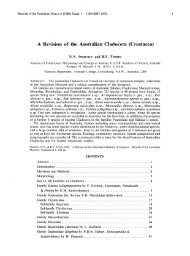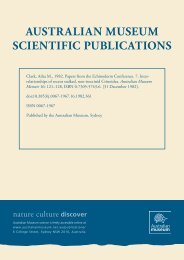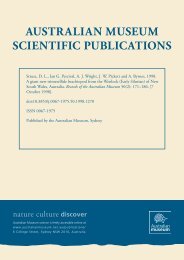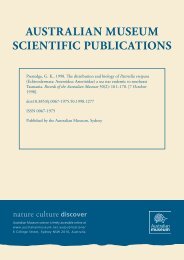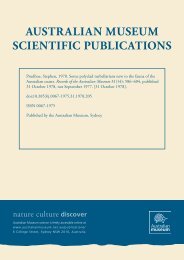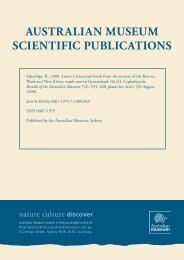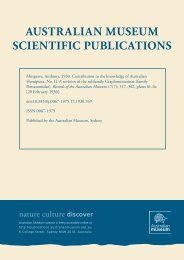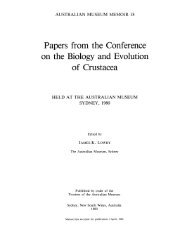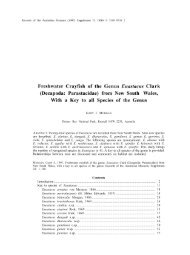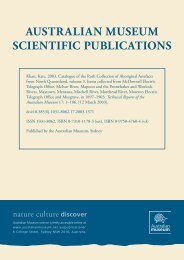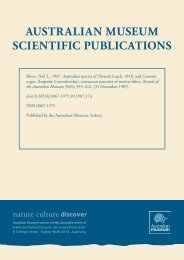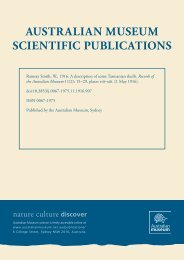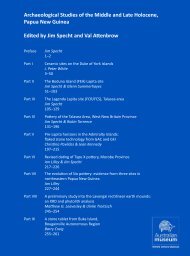Complete work (2104kb PDF) - Australian Museum
Complete work (2104kb PDF) - Australian Museum
Complete work (2104kb PDF) - Australian Museum
Create successful ePaper yourself
Turn your PDF publications into a flip-book with our unique Google optimized e-Paper software.
AUSTRALIAN MUSEUM<br />
SCIENTIFIC PUBLICATIONS<br />
Griffin, D.J.G., 1969. Notes on the taxonomy and zoogeography of the<br />
Tasmanian grapsid and ocypodid crabs (Crustacea, Brachyura). Records of the<br />
<strong>Australian</strong> <strong>Museum</strong> 27(18): 323–347. [18 April 1969].<br />
doi:10.3853/j.0067-1975.27.1969.452<br />
ISSN 0067-1975<br />
Published by the <strong>Australian</strong> <strong>Museum</strong>, Sydney<br />
nature culture discover<br />
<strong>Australian</strong> <strong>Museum</strong> science is is freely accessible online at at<br />
www.australianmuseum.net.au/publications/<br />
6 College Street, Sydney NSW 2010, Australia
NOTES ON THE TAXONOMY AND<br />
ZOOGEOGRAPHY OF THE<br />
TASMANIAN GRAPSID AND OCYPODID<br />
CRABS (CRUSTACEA, BRACHYURA)<br />
Figures I-ID<br />
By D. J. G. GRIFFIN<br />
<strong>Australian</strong> <strong>Museum</strong>, Sydney<br />
ABSTRACT<br />
Manuscript received, 19th March, 1968<br />
Seven of the eleven species of shore crabs of the families Grapsidae and<br />
Ocypodidae occurring in Tasmania are considered; synonymies, detailed locality<br />
lists and comments on previous <strong>work</strong> are given; the remaining four species have<br />
been recently discussed in detail elsewhere by Campbell and Griffin (1966). The<br />
sesarmine Paragrapsus laevis (Dana) is recorded definitely from Tasmania for the<br />
first time. The status of this species and of Leptograpsodes octodentatus (H. Milne<br />
Edwards) is discussed. The zoogeographical relations of the Tasmanian grapsid<br />
and ocypodid fauna are considered.<br />
INTRODUCTION<br />
Until recently, ten species of shore crab belonging to the families Grapsidae<br />
and Ocypodidae were considered to be present in Tasmania. Except for two<br />
widespread species, the majority of these were described by the French carcinologist<br />
H. Milne Edwards around the middle of last century. Previous <strong>Australian</strong><br />
monographs on Crustacea (Haswell, I882b; Hale, I927a) had dealt briefly with<br />
most of these, M. W. F. Tweedie (1942) had treated the Tasmanian species in more<br />
detail, whilst Guiler (I952a, 1956) gave additional distributional data. Recently,<br />
Campbell and Griffin (1966) have given detailed revisions of those species belonging<br />
to the subfamily Sesarminae. The included Tasmanian species were Cyclograpsus<br />
granulosus, Helograpsus haswellianus, Paragrapsus quadridentatus, and P. gaimardii. In<br />
the present paper the taxonomy of these species is not further considered. Another<br />
species dealt with by Campbell and Griffin was Paragrapsus laevis. The evidence<br />
they had available then suggested that this species probably does not occur in<br />
Tasmania, but in the present paper it is recorded from a few localities on the central<br />
east coast and one on the north coast; the taxonomic status of these populations<br />
is discussed.<br />
As Campbell and Griffin (1966: 141) noted, the grapsid described by<br />
Jacquinot (in Jacquinot and Lucas, 1853) from "Hobart", Cyclograpsus tasmanicus,<br />
cannot be identified with any known species of Cyclograpsus or with any Tasmanian<br />
crab, and its status must remain uncertain for the present. During the course of<br />
the studies reported in part here, the status of two geographically widespread species,<br />
Leptograpsus variegatus and Plagusia chabrus, were investigated throughout their range.<br />
The results of these studies will be given in detail elsewhere and the two species are<br />
only briefly dealt with here.<br />
Rec. Aust. Mus., 27, page 323<br />
G 70524-1
Dr R. W. George has recently completed a study of the species previously<br />
known as Brachynotus octodentatus and has considered that it should be placed in the<br />
genus Leptograpsodes. This placing is followed here, and George's studies are<br />
commented upon.<br />
In the present paper, then, brief notes are given on five of the nine species<br />
of Tasmanian grapsids and the two species of ocypodid. Except in the case of the<br />
two widespread species mentioned above, and of Paragrapsus laevis, full synonymies<br />
are given. All Tasmanian localities at which each species is known to occur are<br />
listed and those important morphological features not previously mentioned in the<br />
literature are described. The taxonomic status of Leptograpsodes octodentatus,<br />
Brachynotus spinosus, and Paragrapsus laevis is discussed. Finally, the zoogeographical<br />
relations of the Tasmanian grapsid and ocypodid fauna are considered.<br />
Terminology used here follows that used by Campbell and Griffin (1966)<br />
and by Rathbun in her various publications. Dimensions given are carapace widths<br />
in mm as measured with vernier or dial calipers.<br />
The material on which this study was based has been deposited in the<br />
Tasmanian <strong>Museum</strong>, Hobart; Queen Victoria <strong>Museum</strong>, Launceston; <strong>Australian</strong><br />
<strong>Museum</strong>, Sydney; Dominion <strong>Museum</strong>, Wellington; and D.S. National <strong>Museum</strong>,<br />
Washington.<br />
Restricted synonymy:<br />
TAXONOMY<br />
Family GRAPSIDAE<br />
Subfamily GRAPSINAE<br />
Genus Leptograpsus H. Milne Edwards, 1853<br />
Cancer variegatus Fabricius, 1793: 450.<br />
Leptograpsus variegatus (Fabricius)<br />
Leptograpsus variegatus; Tweedie, 1942: 14. Guiler, 1952a: 40. Guiler, in Guiler,<br />
Serventy and Willis, 1958: 182. Bennett, 1964: 80.<br />
Material examined.-A total of 20 specimens (12 c3c3, 8
As will be shown in a future paper, Western <strong>Australian</strong>, New Zealand, and<br />
South American populations form a single specific unit taxonomically, as previously<br />
reported by Rathbun (1918), Garth (1957), and Bennett (1964).<br />
Genus Leptograpsodes Montgomery, 1931<br />
Leptograpsodes octodentatus (H. Milne Edwards)<br />
Figs. I, 2a-c, 3a<br />
Cyclograpsus octodentatus H. Milne Edwards, 1837: 80 (type locality: King 1., Bass<br />
Strait; type in <strong>Museum</strong> National d'Histoire Naturelle, Paris-vide Montgomery,<br />
1931).<br />
Heterograpsus octodentatus; H. Milne Edwards, 1853: 194. Kingsley, 1880: 209.<br />
Haswell, 1882 b : 10 I.<br />
Brachynotus octodentatus; Tesch, 1918: 106 (in key). Hale, 1924: 69; 1927a: 182,<br />
fig. 183; 1927b: 312. Balss, 1935: 142. Tweedie, 1942: 16, fig. 2. Guiler,<br />
1952a: 40.<br />
Grapsus inornatus Hess, 1865: 148, pI. vi fig. II (type locality: Sydney; type in<br />
Gottingen <strong>Museum</strong>-vide Montgomery, 1931). De Man, 1887: 699.<br />
Leptograpsodes webhaysi Montgomery, 1931: 452, pI. 25 fig. 5, pI. 28 fig. I, la, Ib<br />
(type locality: Long Island, Abrolhos Islands; types not extant, lost III<br />
transit- vide Montgomery, 1931).<br />
Leptograpsodes octodentatus; George, 1962: 71.<br />
Material examined.-A total of 59 specimens (30 d'd', 29 Cj2Cj2, II-35 mm).<br />
Localities.-Bass Strait: King I.; Hunter I.; Goose I.; Chapel I. Tasmania:<br />
Just W. of Crayfish Ck.; Rocky c.; Hawley Beach, Devonport; Green's Beach;<br />
Low Head; Waterhouse I.; Pirates B.; C. Direction; Blackman's B.; Adventure<br />
B., Bruny I.; Conical Harb. (S. of Pieman R.); just S. of Interview R.; just N. of<br />
Arthur R. (see fig. 8).<br />
Habitat.-On boulder beaches and rocky platforms exposed to moderate surf and<br />
in sheltered bays, above high tide level, under stones or in crevices, sometimes in<br />
burrows in earth, often near freshwater seepages.<br />
Distribution.-Restricted to Australia, from the Abrolhos Islands in the west, through<br />
South Australia, Victoria, to northwestern, northern, and eastern coasts of Tasmania;<br />
not found on the east coast of the mainland north of Victoria (F. A. McNeill, personal<br />
communication to R. W. George). George (1962) reported a total of twenty-seven<br />
localities known at that time (see fig. 9).<br />
Description.-A detailed description of this species was given by Montgomery (193 I )<br />
and a shorter one by Tweedie (1942); the synonymous Grapsus inornatus Hess was<br />
redescribed by De Man (1887). Additional features are as follows:<br />
Male abdomen.-Seven-segmented, widest at the middle of the laterally<br />
convex third segment, following segments narrowing uniformly, edges weakly concave,<br />
to distal edge of sixth; seventh segment laterally strongly concave basally.<br />
Male first pleopod.-Long, quite slender, weakly curved outwards distally,<br />
sternal surface with a moderately long groove towards medial surface ending in distal<br />
flap; lateral surface sparsely setose, medial surface with numerous setae extending<br />
from base to tip; a moderately dense tuft of setae at the tip almost concealing short,<br />
blunt, horny tip and flap on sternal surface.
d f<br />
Figure 2.-Male left first pleopods of Leptograpsodes octodentatus, 33 mm, Pirates Bay (a-c) and<br />
Brachynotus spinosus, 17 mm, Pittwater (cl-f): a, d, tip of pleopod, abdominal aspect; b, e, whole<br />
pleopod, abdominal aspect; c, f, tip of pleopod, sternal aspect.
Subfamily V ARUNINAE<br />
Genus Brachynotus De Haan, 1835<br />
Brachynotus spinosus (H. Milne Edwards)<br />
Figs. 2d-f, 3b-e<br />
Heterograpsus spinosus H. Milne Edwards, 1853: 194. A. Milne Edwards, 1874:<br />
82. Kingsley, 1880: 2IO. De Man, 1891: 56, pI. 4 fig. 15. Ortmann,<br />
1894: 715. Fulton and Grant, 1906: 19.<br />
Brachynotus spinosus; Tesch,19I8: I06 (in key). Tweedie,1942: 16, fig. 3. Guiler,<br />
1952a: 40.<br />
Eriocheir spinosus; Hale, 1927a: 184, fig. 185; 1927b: 312, fig. 2.<br />
Type localiry.-Vanikoro, Santa Cruz, Pacific Ocean; types in <strong>Museum</strong> National<br />
d'Histoire Naturelle, Paris-vide De Man, 1891.<br />
Material examined.-A total of 62 specimens (27 C)'C)', 35 ¥¥, 6-17 mm).<br />
Localities.-Tasmania: Detention R.; just W. of Crayfish Ck.; Triabunna; Double<br />
Ck.; Prosser R. at Orford; Carlton R.; Dunalley B.; Fort Direction; Pittwater;<br />
Bellerive Beach; Sandy B.; Howden; Margate; Oyster Cove; Huon R. at<br />
Lymington.<br />
Habitat.-In estuaries and sheltered bays, intertidal towards high tide level, under<br />
small stones.<br />
Distribution.-Southeastern Australia (see fig. 9), southwest Pacific Ocean.<br />
Fulton and Grant (1906) reported this species from Port Phillip and Hale<br />
(1927b) recorded it from the Bay of Shoals and Busby Island, Kangaroo Island.<br />
Within Tasmania it was recorded from Brown's River and Carlton by Tweedie<br />
(1942) and from north of the Pieman River by Guiler (1952a). McNeill (pers.<br />
comm.) considers that Haswell's (1882) record of Leptograpsodes octodentatus (as<br />
Heterograpsus octodentatus) from the north coast of Tasmania was based on a specimen<br />
of the present species. De Man recorded this species from Upolu, Samoa.<br />
Description.-Good descriptions of this species were given by De Man (1891) and<br />
Tweedie (1942). Additional features are as follows:<br />
Abdomen.-Seven segmented, in the male widest towards distal edge of<br />
laterally convex third segment, following segments smoothly tapering to close to distal<br />
edge of sixth which narrows abruptly, seventh segment much narrower than sixth.<br />
Fifth segment markedly concave laterally.<br />
Male first pleopod.-Moderately stout and hardly tapering; short groove<br />
on sternal surface towards lateral surface ending in definite flap; strong tufts of hairs,<br />
confined to distal part of the pleopod, borne towards tip of flap and surrounding<br />
horny tip of pleopod; a few short hairs extending a little way down abdominal<br />
surface somewhat medially.<br />
Colour.-Dull green or brown with or without white markings, which may<br />
be so extensive as largely or wholly to replace the colour (Tweedie). Innumerable<br />
colour variations occur; some examples are green, others different shades of brown.<br />
Some are very dark brown, with large or small white markings, while others have<br />
the whole upper surface of the carapace milk-white (Hale, I927a). Hale's remarks<br />
apply quite satisfactorily to Tasmanian populations. Banding of the legs is Quite<br />
common.
Figure 3.-Leptograpsodes octodentatus, male, 33 mm, Pirates Bay (a only) and Braclz..vnotus spinosus,<br />
male, 17 mm, Pittwater (b-e): a, b, front of carapace and left orbit, ventral aspect; c, left third<br />
maxilliped, outer aspect; d, right first ambulatory leg, propodus and dactyl, anterior aspect;<br />
e, right fourth ambulatory leg, propodus and rlactyl, posterior aspect.<br />
b
333<br />
Remarks.-A full description of this species was given by Campbell and Griffin (1966),<br />
who dealt briefly with the differences between P. gaimardii and P. laevis and illustrated<br />
and commented upon one specimen from Victoria which appears to be intermediate<br />
between the two species in at least nine characters.<br />
Examination of the specimens from eastern Tasmania similarly revealed at<br />
first some rather striking differences from the typical mainland specimens of this<br />
species. These differences mainly involve four characters: the felting of the propodus<br />
of the first ambulatory leg; the felting of the propodus of the fourth ambulatory leg,<br />
the nature of the junction of the first and second thoracic sternites; and the shape<br />
of the sixth segment of the male abdomen. The marked differences usually existing<br />
between the two species in these characters are set out by Camp bell and Griffin<br />
(1966: 162-9)·<br />
Critical examination of seventeen of these Tasmanian specimens shows,<br />
however, on comparison with six specimens from Victoria and twenty-nine New<br />
South Wales specimens of P. laevis (listed in Campbell and Griffin), that there is a<br />
slight tendency for the former to have:<br />
(I) the felt on the anterior surface of the first ambulatory propodus divided<br />
by a thin naked stripe throughout the length of the segment (2 Tasmanian, 2<br />
Victorian, and I N.S.W. specimen);<br />
(2) the felt on the dorsal surface of the fourth ambulatory propodus confined<br />
to the distal third (9 Tasmanian, I Victorian, and 3 N.S.W. specimens);<br />
(3) the second sternite in the male to be raised above the first (7 Tasmanian,<br />
5 Victorian, and I I N.S.W. specimens);<br />
(4) the sixth segment of the male abdomen to be twice as broad as long (see<br />
table 2).<br />
Table I. Relative growth of three dimensions of the carapace of P. laevis and P.<br />
gaimardii (see fig. 4); x and y are the variables given by the equation y = a + bx;<br />
x in all cases is carapace length. The values of a and b are given (together with<br />
their standard error) for each species and each regression. The significance given<br />
is the sums of squares due to the regression as a percentage of the total sums of<br />
squares.<br />
Species<br />
Area (n)<br />
P. laevis<br />
N.S.W., Victoria, and<br />
Tasmania<br />
P. gaimardii<br />
Victoria and Tasmania<br />
(52) (22)<br />
y interorbital width<br />
a<br />
b<br />
significance<br />
y<br />
a<br />
b<br />
significance<br />
2'95 (0'086)<br />
0·81 (0'015)<br />
98'39<br />
3'28 (0'182)<br />
0'70 (0'021)<br />
98'30<br />
carapace width<br />
-0'47 (0'145) I'IQ (0'268)<br />
1'22 (0'025) 1'02 (0'031)<br />
97'99 98'20
334<br />
Table 2. Ratio width/length of sixth abdominal segment of males of Paragrapsus<br />
species.<br />
Species P. laevis P. gaimardii<br />
Area N.S.W., Victoria, Tasmania Victoria and Tasmania<br />
n 29 6 17 22<br />
Mean 1,68 1'77 1'90 2'08<br />
s 0'070 0'110 0'112 0'096<br />
Range 1'50- 1'70- 1·66- 1'92-<br />
1'96 2'00 2'12 2'28<br />
Whilst these features do represent slight differences between the two groupsin<br />
the case of the last two features there are resemblances to P. gaimardii-they are<br />
not consistent enough to allow any kind of taxonomic separation between Tasmanian<br />
P. laevis and mainland specimens. Equally, there is clear evidence that P. gaimardii<br />
and P. laevis are distinct species. The four features exhibited by the Tasmanian<br />
specimens are sometimes found in mainland ones. Tasmanian specimens show no<br />
differences from other p, laevis in the relative width of the carapace between the<br />
external orbital angles or more posteriorly, dimensions which differ significantly in<br />
P. laevis and P. gaimardii (see fig. 4 and table I).<br />
Restricted synonymy:<br />
Cancer chabrus Linnaeus, 1758: 628.<br />
Subfamily PLAGUSIINAE<br />
Genus Plagusia De Haan, 1835<br />
Plagusia chabrus (Linnaeus)<br />
Plagusia capensis; Tweedie, 1942: 22. Guiler, 1952a, 41; 1956 : 7.<br />
Plagusia chabrus; Bennett, 1964: 85.<br />
Material examined.-A total of 12 specimens (7 d'd', 5 ¥¥, 36-79 mm).<br />
Localities.-Bass Strait: Currie Harb., King 1. Tasmania: Off Stanley; Eddystone<br />
Point; Bicheno; Maria 1.; Adventure B., Bruny Is.<br />
Habitat.-On rocky coasts exposed to light to heavy surf, in crevices and pools below<br />
low tide.<br />
Distribution.-Temperate southern Indian and Pacific Oceans from South Africa<br />
through Australia and New Zealand to Chile. Within Australia this species has<br />
been recorded from several localities in western, southern, and eastern Australia<br />
(see fig. 9). In Tasmania Guiler (1956) records the species from Pt. Puer and Port<br />
Arthur, whilst earlier Fulton and Grant (1906) and Rathbun (1923) had recorded<br />
it from Bass Strait.<br />
Remarks.-Bennett and Pope (1960) found this species at Grant Pt., Bicheno, Sleepy<br />
Bay, C. Forestier, Fossil Island in Pirates Bay, Tasman Island, and Bruny Island<br />
(Elizabeth C. Pope, pers. comm.).<br />
Only Guiler (see above) had previously published Tasmanian localities for<br />
this species; as in the case of Leptograpsus variegatus, Tweedie did not collect any<br />
specimens of P. chabrus from Tasmanian coasts.
Figure 5.-Heloecius cordiformis (a-g), male, 22 mm, Snug Bay (a-c, e-g), female, 20 mm, Margate<br />
(d,f); and Hemiplax latifrons (h-l), male, 26 mm (h-j, 1), female, 21 mm (k only), near Wynyard:<br />
a, h, front of carapace and left orbit, ventral aspect; b, i, male right chela, outer aspect; c, j,<br />
tip of same, inner aspect; d, k, female right chela, outer aspect; e, f, right cheliped, merus and<br />
carpus, oblique inner aspect (e, male; f, female); g, 1, left third maxilliped, outer aspect.
337<br />
The male first pleopod has previously been figured by Guinot (1962).<br />
The carapace, legs, and proximal segments of the chelipeds of this species:<br />
are dark greenish-blue obscurely mottled with brown, the palm of the chelae dull<br />
slate-blue, paler distally and fading to white on the fingers (Tweedie, 1942).<br />
Subfamily MACROPHTHALMINAE<br />
Genus HelDiplax HelIer, 1865<br />
HelDiplax latifrons (Haswell)<br />
Figs. 5h-l; 6d, e; 7d-f<br />
Macrophthalmus latifrons Haswell, 1882a: 549; 1882b: 90. Tesch, 19 15: 154-5·<br />
Microphthalmus latifrons; Fulton and Grant, 1906: 19 (incorrect subsequent spelling<br />
of Macrophthalmus Heller).<br />
Hemiplax latifrons; Etheridge and McCulloch, 1916: 13, pl. iv figs. 4-5; pI. vi figs.<br />
2-4. Hale, 1927a: 186, fig. 187. Tweedie, 1942: 25, fig. 10. Guiler, 1952a: 41.<br />
Type.-Holotype, a male, carapace width 29.6 mm, a dry specimen fixed on glass<br />
with printed label "Type Macrophthalmus latifrons, Hasw. Loc. Port Phillip,<br />
Victoria" and registered as P.697; <strong>Australian</strong> <strong>Museum</strong>, Sydney. The carapace<br />
is slightly fractured, the first right ambulatory leg is missing and all the right<br />
ambulatory legs, except the first, are independently fixed to the glass.<br />
Material examined.-A total of 77 specimens (45 66, 32 ¥¥, 8-26 mm).<br />
Localities.-Tasmania: Wynyard; Swan B., Tamar R.; Prosser R. at Orford;<br />
Carlton R. near Carlton; Eaglehawk B.; Coal R.; Pittwater; Risdon Cove;:<br />
Brown's R.; North West B.; Margate; Snug B.; Huon R. at Franklin.<br />
Habitat.-In muddy estuaries, intertidal, in burrows (see Griffin, 1965).<br />
Distribution.-Confined to southeastern Australia, from St Vincent's Gulf through<br />
Victoria to Tasmania (see fig. 10). This species has been reported from Orford<br />
and the Carlton River in Tasmania (Tweedie) and from a few localities in Victoria<br />
and South Australia (Fulton and Grant; Hale).<br />
Remarks.-A reasonably good description of this species was provided by Tweedie<br />
(1942: 25, fig. 10) and it has also been figured by Hale (1927a: fig. 187).<br />
The second to fourth ambulatory legs are densely felted in both sexes, the<br />
first leg being naked with the merus finely tuberculate along the edges.<br />
The male pleopod bears a dense fringe of plumose setae along its lateral<br />
surface. The distal flap is almost wholly on the sternal surface and the tip bears<br />
quite a dense cluster of simple setae.<br />
Supplementary characters include the presence of poorly expanded, deeply<br />
serrate spooned hairs on the tip of the endopoditeof the second maxilliped and of<br />
sh"Ilple hairs on the inner edge of the merus.<br />
Individuals of this species are generally dark greenish or greyish brown, the<br />
chelae paler (Tweedie, 1942). The underside of the body is also pale and there<br />
may be a transverse band of pale pink across the central sternites.
d<br />
339<br />
a b c<br />
e<br />
Figure 7.-Ma1e first pleopods of Heloecius cordiformis (a-c) and Hemiplax latifrons (d-f) , same<br />
specimens as in fig. 5: a, d, tip of pleopod, abdominal aspect; b, e, whole pleopod (except<br />
base), abdominal aspect; c, f, tip of pleopod, sternal aspect.
H. latifrons can be easily distinguished from the New Zealand congener H.<br />
hirtipes (Jacquinot) by the slightly narrower front [from a quarter to a fifth carapace<br />
width (Tweedie) as opposed to one-third carapace width in the New Zealand species<br />
Richardson, 1949a: 36.] Examination of material of H. hirtipes (an adult male and<br />
female-AM P.700-in the <strong>Australian</strong> <strong>Museum</strong>'s collections) show the following<br />
other differences between the two species:<br />
(I) the eyestalks are slender and reach fully to the tip of the exorbital spine<br />
in H. latifrons but are stout in H. hirtipes and shorter, not nearly reaching the exorbital<br />
spine;<br />
(2) the carapace widens markedly posteriorly in H. latifrons but narrows<br />
in H. hirtipes J'<br />
(3) the anterolateral margin bears two broad, rounded lobes behind the<br />
orbit in H. latifrons and two sharp flattened spines, in H. hirtipes;<br />
(4) the carpus of the cheliped is long and slender in H. latifrons without<br />
a spine but short and fairly stout in H. hirtipes with a dorsal spine on the inner<br />
surface.<br />
The relationship of H. latifrons to species of Macrophthalmus requires further<br />
elucidation in view of these strong differences from H. hirtipes.<br />
ZOOGEOGRAPHY AND RELATIONSHIPS OF THE TASMANIAN<br />
GRAPSID AND OCYPODID FAUNA<br />
Of the eleven Tasmanian grapsids and ocypodids, all but two are widely<br />
distributed around Tasmania. These two are Leptograpsus variegatus and Paragrapsus<br />
laevis, which appear to be confined to the northern part of the east coast, perhaps<br />
due to the influence of the warm East <strong>Australian</strong> current. Previously, L. octodentatus<br />
has been reported only from the north coast. This species is, however, quite widely<br />
distributed around Tasmania.<br />
None of the species is confined to Tasmania. However, five species are<br />
otherwise known only from Victoria and eastern South Australia. These are C.<br />
granulosus, P. quadridentatus, P. gaimardii, and H. latifrons, which are endemic to<br />
Australia, and B. spinosus, which is known also from two localities in the central-west<br />
Pacific Ocean. The distributional limits of these species are additional evidence<br />
for the existence of the southeastern <strong>Australian</strong> "Maugean" marine province<br />
(Bennett and Pope, 1953, 1960).<br />
Of the remaining six species, three (H. haswellianus, P. laevis, and H. cordiformis)<br />
have an eastern distribution in Australia, being known from as far north as Brisbane<br />
(Queensland) and along Victorian coasts; the distribution of H. haswellianus also<br />
includes South Australia. Of those species which occur outside Victoria and South<br />
Australia, L. octodentatus is the only one which is not known from central eastern<br />
Australia. The distribution of this species is western; it is not known outside<br />
Australia.<br />
Two species only, L. variegatus and P. chabrus, are widespread outside Australia.<br />
Within Australia, both species are widely distributed southern forms.<br />
The distribution patterns of the eleven are compared in table 3; text-figure<br />
8 shows the Tasmanian distribution of four species, the two with limited eastern<br />
distributions and two with wider distributions. Text-figures 9 and IQ show the<br />
<strong>Australian</strong> distributions of all species.
343<br />
C yclograpsu5 granulosus<br />
(and c. audournii)<br />
,<br />
....<br />
". ". " ;<br />
Paragrapsus quadridentatus<br />
Figure g.-Known geographical distribution, within Australia, of the nine species of Tasmanian<br />
Grapsidae. In the case of Plagusia, Cyclograpsus, and Paragrapsus species the distribution of one<br />
congener (P. dentipes, C. audouinii, and P. laevis) is shown by open, instead of filled, circles. As<br />
far as possible each circle represents a single locality; distribution of Leptograpsodes octodentatus<br />
after George (lg62).<br />
..... ,<br />
( Q
344<br />
of the species L. variegatus and P. chabrus and of the genera Cyclograpsus and Hemiplax.<br />
Numerous similarities between the distribution patterns of southern temperate<br />
intertidal floras and faunas have been reviewed by Guiler (I95'2C), Knox (I960, I963),<br />
and others. However, New Zealand, which, like Tasmania, possesses few grapsids<br />
and ocypodids (Bennett, I964), differs notably from Tasmania in the dominance<br />
of many of its shores by varunines of the genus Hemigrapsus, not by sesarmines. The<br />
New Zealand species of this genus are markedly different from the Tasmanian<br />
varunine Brachynotus spinosus. It is doubtful, too, if the <strong>Australian</strong> Hemiplax latifrons<br />
is more closely related to the New Zealand H. hirtipes than to species of the Indo<br />
Pacific genus Macrophthalmus, which is well represented on warm temperate to tropical<br />
<strong>Australian</strong> shores.<br />
Chile (Garth, I957) shares two species with Tasmania (see table I) and,<br />
apart from this, one genus, Cyclograpsus. The two species of the latter genus are<br />
quite different from Australasian species, one, C. punctatus, being found also in South<br />
Africa, which possesses one species in common with Tasmania. Both Chile and<br />
South Africa (Barnard, I950) possess varunines rather different from Tasmanian<br />
ones (species of Crytograpsus, Hemigrapsus, and Aratus in Chile and of Varuna in South<br />
Africa). The similarities of the grapsid faunas of southern temperate regions due<br />
to sharing of L. variegatus and P. chabrus may be accounted for by the possible<br />
existence in these species of relatively long-living larvae, widely travelling by means<br />
of the West Wind Drift. The Tasmanian grapsids and ocypodids appear to show<br />
similar patterns in their geographic distributions and relationships to those of other<br />
<strong>Australian</strong> Brachyura (e.g., portunid crabs-Stephenson, I962; majid crabs<br />
Griffin, I 966).<br />
Heloeciu5 cordiformis<br />
Hemiplax latifrons<br />
Figure IO.-Known geographical distribution of the two species of Tasmanian Ocypodidae.<br />
ACKNOWLEDGEMENTS<br />
The studies reported here were carried out at the University of Tasmania and were<br />
financed by research grants to that university; this report formed part of a thesis submitted in<br />
fulfilment of the requirements for the degree of Ph.D. at the University of Tasmania, and I wish<br />
to thank Dr E. R. Guiler for his supervision of the research. I also would like to express my<br />
appreciation to Dr J. C. Yaldwyn (<strong>Australian</strong> <strong>Museum</strong>) and Emeritus Professor V. V. Hickman<br />
(University of Tasmania) for commenting on the manuscript; Dr R. W. George (Western<br />
<strong>Australian</strong> :<strong>Museum</strong>) for allowing me to include here a summary of the previously unpublished<br />
results of his study of Leptograpsodes octodentatus; Mr B. M. Gampbell (Queensland <strong>Museum</strong>) for<br />
helpful discussion; Mrs Julia Greenhill (Tasmanian <strong>Museum</strong>, Hobart) and Mr R. H. Green<br />
(Queen Victoria <strong>Museum</strong>, Launceston), for kindly allowing me to examine collections under<br />
their care, and Miss Elizabeth C. Pope (<strong>Australian</strong> <strong>Museum</strong>) for her kindness in allowing me to<br />
ccnsult original, partly unpublished, data on the distribution of some of these species.
345<br />
REFERENCES<br />
BALSS, H., 1935. Brachyura of the Hamburg <strong>Museum</strong> expedItion to south-western Australia,<br />
1905. ]. R. Soc. West. Aust. 21: 113-151, figs. 1-5, pI. 13.<br />
BARNARD, K. H., 1950. Descriptive catalogue of the South African decapod Crustacea (crabs<br />
and shrimps). Ann. S. Afr. Mus. 38: 1-837, figs. 1-154.<br />
BENNETT, E. W., 1964. The marine fauna of New Zealand: Crustacea Brachyura. Bull.<br />
NZ. Dep. scient. ind. Res. 153: 1-120, figs. 1-141.<br />
BENNETT, Isobel, and Elizabeth C. POPE, 1953. Intertidal zonation of the exposed rocky<br />
shores of Victoria, together with a rearrangement of the biogeographical provinces of temperate<br />
<strong>Australian</strong> shores. Aust.]. mar. Freshwat. Res. 4: I05-159, figs. 1-5. pis. 1-6.<br />
BENNETT, Isobel, and Elizabeth C. POPE, 1960. Intertidal zonation of the exposed rocky<br />
shores of Tasmania and its relationship with the rest of Australia. Aust. 7. mar. Freshu)at.<br />
Res. II: 182-221, 2 tables, figs. 1-3, pis. 1-7.<br />
CAMPBELL, B. M., and D. J. G. GRIFFIN, 1966. The <strong>Australian</strong> Sesarminae (Crustacea<br />
Brachyura): genera Helice, Helograpsus nov., C,YClograpsus and Paragrapsus. Mem. Qd Alus.<br />
14: 127-174, text-figs. I-IO, pis. XX-XXIII.<br />
CHI LT ON, c., and E. W. BENNETT, 1929. Contributions for a revision of the Crustacea<br />
Brachyura of New Zealand. Trans. NZ. Inst. 59: 731-778.<br />
CRANE, Jocelyn, 1941. Eastern Pacific Expeditions of the New York Zoological Society.<br />
XXVI. Crabs of the genus Uca from the west coast of central America. Zoologiea, N.r.<br />
26: 145-208, text-figs. 1--8, pis. I-IX. -<br />
DANA, J. D., 1852a. Conspectus Crustaceorum quae in Orbis Terrarum circumnavigatione<br />
Carolo Wilkes e Classe Republicae Foederate Duce lexit et descripsit. Proc. Acad. nat. Sci.<br />
Philad. 5: 247-254, 267-272.<br />
DANA, J. D., 1852b. Crustacea. In U.S. Exploring Expedition during the years 1838-42<br />
under the command of Charles Wilkes, U.S.N. 13: I-VIII, 1-1618. Atlas (1855): 1-27,<br />
pis. 1-96. C. Sherman, Philadelphia.<br />
ETHERIDGE, R., Jr, and A. R. McCULLOCH, 1916. Sub-fossil crustaceans from the coasts<br />
of Australia. Ree. Aust. Mus. I I: 1-14, fig. I, pis. 1-7.<br />
FABRICIUS, J. C., 1793. Entomologia systematica emendata et aucta, secundum classes, ordines,<br />
genera, species, adjectis synonymis, locis, observationibus, descriptionibus. VoI. 2: i-viii,<br />
1-519. C. Gottlieb, Hafniae (Copenhagen).<br />
FULTON, S. W., and F. E. GRANT, 1906. Census of the Victorian decapod Crustacea.<br />
Part I. Brachyura. Proe. R. Soc. Viet. ser. 2, 19: 16-20.<br />
GARTH, J. S., 1957. Reports of the Lund University Chile Expedition 1948--49. 29. The<br />
Crustacea Decapoda Brachyura of Chile. Acta. univ. lund, n.f. 2, 53 (7): 1-127, figs. 1-;-1 I,<br />
pis. I-IV.<br />
GEORGE, R. W., 1962. The Burrowing Shore Crab of southern Australia. Aust. nat. hist.<br />
14: 71-74, illus.<br />
GRIFFIN, D. ]. G., 1965. The behaviour of shore crabs. Aust. nat. Hist. 15: 87-91, iUns.<br />
GRIFFIN, D. J. G., 1966. A review of the <strong>Australian</strong> majid spider crabs (Crustacea, Brachyura).<br />
Aust. Zool. 13: 259-298, figs. 1-3, pis. XV-XVII.<br />
GUILER, E. R., 1952a. A list of the Crustacea of Tasmania. Rec. Queen Vict. Mus. 3: 15-44·<br />
GUILER, E. R., 1952b. The ecological features of certain sheltered intertidal areas in Tasmania.<br />
Pap. Proc. R. Soc. Tas. 86: I-I I.<br />
GUILER, E. R., 1952C. The nature of intertidal zonation in Tasmania. Pap. Proc. R. Soc.<br />
Tas. 86: 71-I06.<br />
GUILER, E. R., 1956. Supplement to a list of the Crustacea of Tasmania. Rec. Queen Viet.<br />
Mus. n.s. 5: 1-8.<br />
GUILER, E. R., D. L. SERVENTY and J. C. WILLIS, 1958. The Fisher Island Field<br />
Station-with an account of its principal fauna and flora. Pap. Proc. R. Soc. Tas.92: 165-183,<br />
pis. I, II.<br />
GUINOT, Daniele, 1962. Sur quelques Crustaces Decapodes Brachyoures indo-Pacifique des<br />
collections du Musee de Munich. Opusc. zool. Bpest 60: 1-14, figs. l-IO.
ADDENDUM<br />
Since this paper was written Griffin (Crustaceana 15: 210-213, 1968) has designated the lectotypeof<br />
Plagusia capensis De Haan, 1835, as the neotype of Cancer chabrus Linnaeus, 1758.<br />
Barnes (Trans. zool. Soc. Lond. 31 : 239, 1968) has returned Hemiplax latifrons (Haswell,) to the genus.<br />
Macrophtha!mus and created for it the new subgenus (Tasmanoplax. Hemiplax hirtipes (Jacquinot)<br />
has been transferred to Macrophthalmus, Hemiplax being considered as a subgenus.<br />
v. C. N. Blight, Government Printer, New South Wales-19C9




